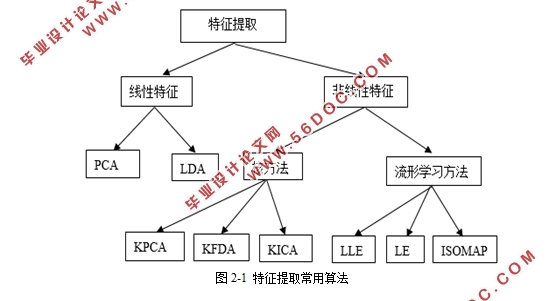面向反馈神经网络进化特征提取算法研究
来源:wenku7.com 资料编号:WK716437 资料等级:★★★★★ %E8%B5%84%E6%96%99%E7%BC%96%E5%8F%B7%EF%BC%9AWK716437
以下是资料介绍,如需要完整的请充值下载。
1.无需注册登录,支付后按照提示操作即可获取该资料.
2.资料以网页介绍的为准,下载后不会有水印.资料仅供学习参考之用. 密 保 惠 帮助
资料介绍
面向反馈神经网络进化特征提取算法研究(论文12500字,外文翻译)
摘要:全面与维数灾难的矛盾是大数据时代网络态势感知需要解决的首要难题。特征提取一直是主流的降维方法,特征提取[1]是模式识别领域的一个重要的研究方向,特征提取可以提高分类的效率与效果,然而,现有的算法对于高维非线性数据并不适用;深度学习是一类具有多层非线性映射的学习算法,它可以对复杂函数进行近似,但对隐含层相关参数很敏感。
我们知道[2]人类大脑信息的传递和对外界刺激的反应是由神经元控制的。人类的大脑由数十亿个这样的神经元组成。这些神经元并不是孤立的,而且密切相关,每个神经元连接到平均数千个神经元,从而构成人脑的神经网络。刺激在神经网络中以一定的规则传播。神经元每次受到其他神经的刺激时,都不会都做出反应,它首先会积累来自邻近神经元的刺激,并在一定时间内产生自己的刺激,并将其传递给邻近的神经元。以这种方式工作的数十亿神经元构成了人脑对外界的反应,人脑学习外界刺激的机制是通过调节这些神经元与它们的力量之间的联系。当然,上面所说的是人脑真正神经工作的简化生物学模型,使用这种简化的生物模型,可以将其扩展到机器学习,并将其描述为一个人工神经网络。BP神经网络就是其中之一。
针对上述问题,将进化算法思想引入深度学习,本文通过思维进化算法优化BP神经网络,提出了一种基于思维进化学习的特征提取算法。该算法随机提取“data.mat”中的数据来进行编程,其利用遗传算法及进化策略实现全局搜索及优化的特点,并对相关参数和深度学习结构进行了优化,进一步降低了数据的维度,理论分析和实验结果验证了此算法的有效性,达到了能够有效的提高特征精度的效果。
关键词:特征提取;进化算法;BP神经网络
Research on Evolutionary Feature Extraction Algorithm Based on Feedback Neural Network
Abstract:The contradiction between full-scale and dimensional disasters is the primary problem that needs to be resolved in the era of network situational awareness in the era of big data. Feature extraction has always been the mainstream dimension reduction method. Feature extraction is an important research direction in the field of pattern recognition. Feature extraction can improve the efficiency and effectiveness of classification. However, existing algorithms do not perform well for high-dimensional nonlinear data; deep learning is a type of A learning algorithm with multiple layers of non-linear mapping can complete the approximation of complex functions, but it is very sensitive to hidden layer related parameters. To solve the above problems, the idea of evolutionary algorithm is introduced into deep learning, and a feature extraction algorithm based on thinking evolutionary learning is proposed. The algorithm uses genetic algorithms and evolutionary strategies to achieve the characteristics of global search and optimization, and optimizes the deep learning structure and related parameters. Theoretical analysis and experimental results have proved the effectiveness of the algorithm.
We know that the transmission of human brain information and the response to external stimuli are controlled by neurons. The human brain consists of billions of such neurons. These neurons are not isolated and closely related. Each neuron is connected to an average of several thousand neurons and thus constitutes a neural network of the human brain. Stimuli propagate in the neural network following certain rules. A neuron does not react every time it receives stimulation from other nerves. It will first accumulate the stimuli coming from its neighboring neurons and, at a certain time, will generate its own stimuli and pass it on to some of its adjacent neurons. The billions of neurons that work in this way constitute the reaction of the human brain to the outside world. The mechanism by which the human brain learns external stimuli is by regulating the connections between these neurons and their strength. Of course, the above is actually a simplified biological model of the true neural work of the human brain. Using this simplified biological model, it can be extended to machine learning and described as an artificial neural network. The BP neural network is one of them.
In this paper, the BP neural network is optimized by the mind-evolution algorithm, and the data dimension is further reduced. The data in the ‘data.mat’ is extracted at random for programming, and the effect of effectively improving the feature accuracy is achieved.
Key words:Feature Extraction;Evolutionary Algorithm; BP Neural Network

目录
第 1章 绪论 3
1.1 研究背景 3
1.2 研究现状 3
1.3 本文工作 4
第2章 特征提取的技术介绍 4
2.1 线性特征提取 5
2.1.1 主成份分析 5
2.1.2 线性判别分析 5
2.1.3 基于特征提取的RELIEF算法 6
2.2 非线性特征抽取 6
2.2.1 核方法 7
2.2.2 流形学习方法 7
第3章 进化(EC)计算研究 7
3.1 遗传算法 7
3.1.1 计算示例 8
3.2 思维进化算法 10
3.2.1 思维进化算法的基本思路 11
3.2.2 思维进化算法特点 11
第4章 思维进化算法优化BP神经网络 11
4.1 BP神经网络介绍 11
4.1.1 BP神经网络的概述 12
4.1.2 基于BP神经网络进化算法特征提取 14
4.2 思维进化算法实现 15
4.2.1 初始种群产生 15
4.2.2 子种群产生 16
4.3 MATLAB实现 16
4.3.1 创建并训练BP神经网络 17
4.3.2 结果分析 18
第5章 结论 20
参考文献 20
|



